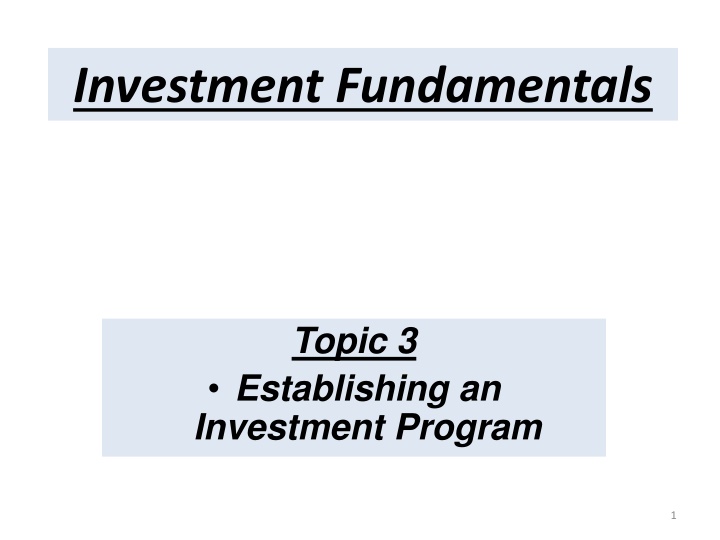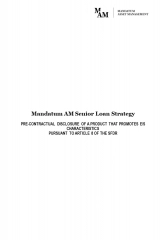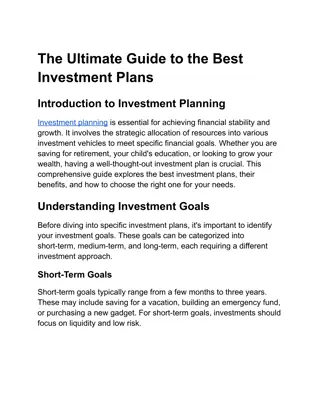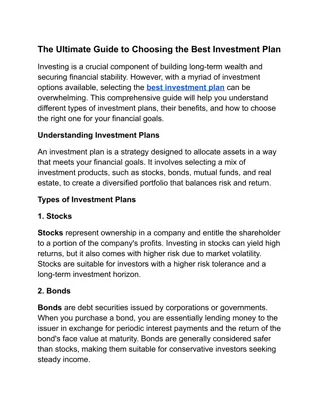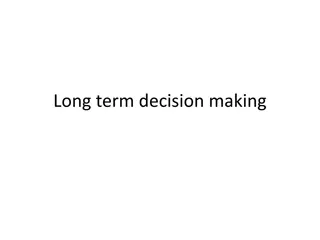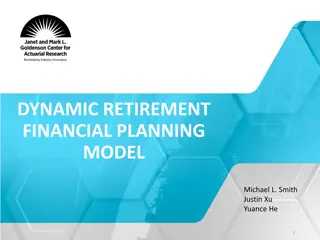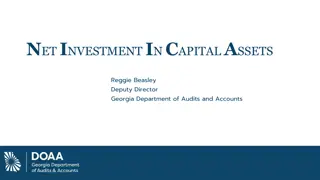Financial Planning Essentials: Establishing a Solid Investment Program
Explore the key steps involved in establishing an investment program, including assessing current financial conditions, setting financial goals, budgeting, understanding investment goals, and managing personal debt. Dive into the importance of liquidity, factors influencing investment decisions, and insights on financial bondage. Discover valuable tips from financial experts and analyze the challenges faced by the long-term unemployed during job searches.
Download Presentation

Please find below an Image/Link to download the presentation.
The content on the website is provided AS IS for your information and personal use only. It may not be sold, licensed, or shared on other websites without obtaining consent from the author.If you encounter any issues during the download, it is possible that the publisher has removed the file from their server.
You are allowed to download the files provided on this website for personal or commercial use, subject to the condition that they are used lawfully. All files are the property of their respective owners.
The content on the website is provided AS IS for your information and personal use only. It may not be sold, licensed, or shared on other websites without obtaining consent from the author.
E N D
Presentation Transcript
Investment Fundamentals Topic 3 Establishing an Investment Program 1
Planning 1. Assessing Current Financial Conditions a. The Personal Balance Sheet b. The Personal Income Statement c. Relationship between the two statements d. Assessing your current position 2. Establishing Financial Goals 3. Budgeting for Goal Achievement
Investment Goals and Plans 1. Key Factors a. Return b. Risk c. Taxes 2. Providing Needed Liquidity a. Liquidity b. Three reasons for having liquid assets on hand 3. Quantifying Investment Goals
Personal Debt (Financial Bondage) 1.In 1960: Average median income was approximately $6,700 and 8% was paid in direct taxes including Social Security. Home costs amounted to 22% of net income. 2. In 2014: Average median income was approximately $52,200 and 42% was paid in direct federal, social security and state taxes, plus other local (sales, gas, property, and excise taxes). Home costs amounted to 40% of net income.
Help! http://www.usdebtclock.org
Only about 11 percent of the long-term jobless find jobs each month, little better than in the depths of the recession. Moreover, even those who do find jobs are often able to find only part-time or short- term work. If they aren t finding jobs, what s happening to the long-term unemployed? They re dropping out of the labor force altogether. As the chart below shows, the share of the long-term jobless who are giving up their job searches has been rising steadily, even as the job-finding rate has remained largely flat. (Not shown on the chart are the more than 50 percent who remain unemployed.) Many long-term unemployed are simply giving up. More than one-third will be out of the labor force a year later, meaning they re neither working nor looking for work. Most of them say they no longer even want a job, suggesting they re unlikely to return to the job market in the future.
FINANCIAL BONDAGE DROWNING IN DEBT The Rich rule over the poor, and the borrower becomes the lenders slave. - Proverbs 22:7 If you re smart, you don t need debt. If you re dumb, it s poisonous. - Warren Buffett If you re thrifty you don t need debt. If you re stupid, it s all you ve got . - Prof. Kuhle
Symptoms of Financial Bondage 1. Overdue Bills 2. Worrying over investments. 3. Get-Rich-Quick Attitude; Those who attempt to make money fast usually fail. 4. No desire for gainful employment and a sense of being overwhelmed 5. Being Deceitful; Shading the truth about a financial product you may be selling
Symptoms of Financial Bondage 6. Being Greedy; Always wanting more than you have to the exclusion of family members 7. Trying to keep up with the Jones 8. Not meeting family needs 9. Over commitment to work 10. Financial resentment
Red Flags Retirement Accounts Private retirement accounts are beneficial because they form voluntary savings, and the majority of these funds are reinvested in the economy. However, these same funds are an attractive solution to solve the solvency problems of Social Security and Medicare/Medicaid.
Red Flags (continued) Social Security in 1991: $269 billion went to retirement benefits $105 billion went to Medicare $28 billion went back to the general fund Total: $402 billion For year 2014--$863 BILLION In 1960 there were 14 workers for every retiree. In the year 2014 it will be 1.2 to 1.
Social Security: Our Black Hole Black Hole Social Security is not sustainable over the long term at current benefit and tax rates. In 2010, the program paid more in benefits and expenses than it collected in taxes and other noninterest income, and the 2013 Trustees Report projects this pattern to continue for the next 75 years. The Trustees estimate that the trust fund reserves will be exhausted by 2033. At that point, payroll taxes and other income will flow into the fund but will be sufficient to pay only about 75% of program costs. As reported in the 2013 Trustees Report, the projected shortfall over the next 75 years is 2.72% of taxable payroll. Fast Facts & Figures About Social Security, 2014. What this is basically saying is that the Social Security system is now officially running at a deficit forecasted from now for the next 75 years.
Introduction I. Typical American II. Managing Your Financial Affairs III. Overview of Managing Process
Introduction (continued) A. Establish Your Financial Goals B. Get Started Now By: 1. Paying Yourself First 2. Finding Dollars to Save 3. Emergency Fund C. The Power of Compound Interest--Make it Work for You
Introduction (continued) D. Buying the Right Life Insurance E. Beating Uncle Sam F. Investing for the Future--Using Common Stocks
The Secret of Investing: Compound Interest When asked What is the greatest achievement of human civilization? Albert Einstein answered, The greatest achievement of human civilization must be compound interest. This is the most important thread in the fabric of investing. The Parable of the Grain of Wheat illustrates the power of compound interest. Everything we talk about in this course will be related as to how we can harness the power of compound interest.
Lets say we have two investors, Mr. Bonds and Mr. Stocks. Each has $100,000. Mr. Bonds invests his money in bonds yielding 7%. Mr. Stocks invests his in quality stocks that pay an average of 3% in dividends, however, their appreciation over time, is over 8%. In order for Mr. Stocks to have the same income as Mr. Bonds he must sell part of his portfolio each year. Mr. Stocks will have $111,000 at the end of the first year ($3,000 + $8,000). He has received $3,000 in dividends so he must sell $4,000 to match the income of Mr. Bonds (i.e. $7,000). This will leave Mr. Stocks with a portfolio value of $104,000 instead of $100,000 as Mr. Bonds has. Over a twenty year time period Mr. Stocks portfolio will be worth between $300,000 - $400,000, while Mr. Bonds remains at $100,000. Ah! but someone says, Yeah, but what if the big one hits and the market crashes. Well, during the depression of the 1930 s the solvency of many bonds were in serious doubt. Those companies that failed often had nothing to give there bondholders. As the interest payments could no longer be met, many additional bondholders understood what true risk was.
Compound Interest: Another Example Suppose we have two investors, investor A and investor B. Assume each has $100,000 and can each average 15% per year. Further assume that the investment horizon is 20 years. Assume investor A makes only one trade and holds it for 20 years. Assume investor B, on the other hand, makes just one trade per year and pays the taxes on the capital gains (average of 34%). In twenty years, Investor B will have a portfolio worth approximately $660,000. Investor A s portfolio will be worth close to $2,000,000. Obviously, the ideal investment is the one which will yield double digit returns in the long-run and one you would not have to sell for liquidity. Therefore, the task is to find the growth company that keeps growing all the way to the twentieth year. Remember, our goal is to maximize the power of compound interest. The only way to do so is to buy and hold for a long time.
The Typical American American s save less than 5.0% of their disposable Income. The average for other industrial countries is over 10%. 60% of all retiring Americans do so on $16,000 per year or less. 27% of all retiring Americans do so on income between $16,000 to $20,000. Only 13% of all retiring Americans retire on an annual income greater than $20,000 per year. The average death benefit paid in 2013 was $9,850.
THE TAX SYSTEM EXPLAINED IN COFFEE Suppose that every day, ten men go out for COFFEE AND CONVERSATION and the bill for all ten comes to $100... If they paid their bill the way we pay our taxes, it would go something like this... The first four men (the poorest) would pay nothing. The fifth would pay $1. The sixth would pay $3. The seventh would pay $7. The eighth would pay $12. The ninth would pay $18. The tenth man (the richest) would pay $59. http://arabiangazette.com/wp-content/uploads/2012/09/Coffee-image.jpg The ten men drank COFFEE every day and seemed quite happy with the arrangement, until one day, the owner threw them a curve ball. "Since you are all such good customers," he said, "I'm going to reduce the cost of your daily coffee bill by $20". Unlimited coffee for the ten men would now cost just $80. The group still wanted to pay their bill the way we pay our taxes. So the first four men were unaffected. They would still drink for free. But what about the other six men? How could they divide the $20 windfall so that everyone would get his fair share? They realized that $20 divided by six is $3.33. But if they subtracted that from everybody's share, then the fifth man and the sixth man would each end up being paid to drink THEIR COFFEE.
THE TAX SYSTEM EXPLAINED IN COFFEE So, the owner suggested that it would be fair to reduce each man's bill by a higher percentage the poorer he was, to follow the principle of the tax system they had been using, and he proceeded to work out the amounts he suggested that each should now pay. At a bill of $80, in order to follow the principle of the tax system they had been using, and he proceeded to work out the amounts he suggested that each should now pay. Now, the first four men along with the fifth would pay nothing. The sixth now paid $2 instead of $3 (33% saving). The seventh now paid $5 instead of $7 (28% saving). The eighth now paid $9 instead of $12 (25% saving). The ninth now paid $14 instead of $18 (22% saving). The tenth now paid $49 instead of $59 (16% saving). http://arabiangazette.com/wp-content/uploads/2012/09/Coffee-image.jpg
THE TAX SYSTEM EXPLAINED IN COFFEE Each of the six was better off than before. And the first four continued to drink for free. But, once outside the bar, the men began to compare their savings. "I only got a dollar out of the $20 saving," declared the sixth man. He pointed to the tenth man AND SAID, "but he got $10! "Yeah, that's right," exclaimed the fifth man. "I only saved a dollar too. It's unfair that he got ten times more benefit than me! "That's true!" shouted the seventh man. "Why should he get $10 back, when I only got $2? The wealthy get all the breaks! "Wait a minute," yelled the first four men in unison, we didn't get anything at all. This new tax system exploits the poor! The nine men surrounded the tenth and beat him up. The next night the tenth man didn't show up for COFFEE AND CONVERSATION so the nine sat down and had their COFFEE without him. But when it came time to pay the bill, they discovered something VERY important. They didn't have enough money between all of them for even half of the bill! http://arabiangazette.com/wp-content/uploads/2012/09/Coffee-image.jpg
THE TAX SYSTEM EXPLAINED IN COFFEE And that, my dear students is exactly how our tax system AND how the current administration works. It is called class warfare pitting the rich against the middle class and poor. The people who already pay the highest taxes will naturally get the most benefit from a tax reduction. Tax them too much, attack them for being wealthy, and they just may not show up anymore. In fact, they might start drinking coffee overseas, where the atmosphere is somewhat friendlier. For those who understand this, no explanation is needed. For those who do not understand, no explanation is possible because you never will get it. http://arabiangazette.com/wp-content/uploads/2012/09/Coffee-image.jpg
Here is what happened on January 1st 2014: Top Income Tax bracket went from 35% to 39.6% Top Income Payroll Tax went from 37.4% to 52.2% Capital Gains Tax went from 15 % to 28% Dividend Tax went from 15% to 39.6% Estate Tax went from 0% to 55% These taxes were all passed under the Affordable Care Act, otherwise known as Obama Care.
Taxing the Rich: Economics or Politics?
Remember Who Pays the Most Income % of Total Personal Income Taxes Paid Top 1% 41% Top 10% 71% Top 50% 98% From 2014 IRS Data
Facts About the National Debt If you were alive when Jesus Christ was born and you spent one million dollars every single day since that point in time, you still would not have spent one trillion dollars by now.
Facts About the National Debt It took more than 200 years for the U.S. national debt to reach 1 trillion dollars. In 1986, the U.S. national debt reached 2 trillion dollars. In 1992, the U.S. national debt reached 4 trillion dollars. In 2005, the U.S. national debt doubled again and reached 8 trillion dollars. Now the U.S. national debt is over the 18 trillion dollar mark. How long can this kind of exponential growth go on before a day of reckoning?
Facts About the National Debt If Bill Gates gave every single penny of his fortune to the U.S. government, it would only cover the U.S. budget deficit for 15 days.
Facts About the National Debt Today, the government debt to GDP ratio in the United States is well over 100 percent. A recently revised IMF policy paper entitled An Analysis of U.S. Fiscal and Generational Imbalances: Who Will Pay and How? projects that U.S. government debt will rise to about 400 percent of GDP by the year 2050.
Facts About the National Debt The United States already has more government debt per capita ($58,000) than Greece, Portugal, Italy, Ireland or Spain does. At this point, the United States government is responsible for more than a third of all the government debt in the entire world.
Facts About the National Debt It is being projected that the U.S. national debt will surpass 23 trillion dollars in 2016. Mandatory federal spending surpassed total federal revenue for the first time ever in fiscal 2011. That was not supposed to happen until 50 years from now.
Facts About the National Debt Between 2007 and 2010, U.S. GDP grew by only 4.26%, but the U.S. national debt soared by 61% during that same time period. The U.S. government has total assets of 2.7 trillion dollars and has total liabilities of 18 trillion dollars. The liabilities do not even count 4.7 trillion dollars of intra- governmental debt that is currently outstanding. U.S. households (as a segment of the economy) are now actually receiving more money directly from the U.S. government than they are paying to the government in taxes.
Facts About the National Debt The U.S. government is wasting your money on some of the stupidest things imaginable. For example, in 2011 the National Institutes of Health spent $592,527 on a study that sought to figure out once and for all why chimpanzees throw poop.
Facts About the National Debt The official government debt figure does not even account for massive unfunded liabilities that the U.S. government will be hit with in the years ahead. According to the the U.S. government is facing a future "fiscal gap" of more than 200 trillion dollars.
Facts About the National Debt Obama care is going to cause our debt to balloon in size as well. It is being projected that Obama care will add more than 2.6 trillion dollars to the U.S. national debt over the first decade alone. So where are we going to get all this money? We can't keep spending money that we do not have. We have got to prioritize. Every single category of government spending needs to be cut. But instead we feel like we can keep ripping off future generations of Americans and that we will always be able to get away with it. What we have done to our children and our grandchildren is beyond criminal.
Managing Your Own Financial Affairs You Have the Ability America is still the land of opportunity even with a 42% average tax burden. You have the right to succeed or fail in business and investment. You Need a Roadmap You must have a specific blueprint that outlines and details where you are and where you want to go. There are Six Fundamental Steps in the Managing Process
The Personal Financial Management Process Steps: 1. Establish Your Financial Goals 2. Get Started Now-- 3. Let Time and Compound Interest Work for You 4. Buy Right Life Insurance 5. Beat Uncle Sam With a Retirement Plan 6. Invest for the Future Using Common Stocks
1. Establish Your Financial Goals A. How Much Will You Make in Your Lifetime? Income $20,000 $25,000 $30,000 $40,000 $60,000 $80,000 Earnings $ 800,000 $1,000,000 $1,200,000 $1,600,000 $2,400,000 $3,200,000
A Retirement Example From This to This (In forty years)
1. Establish Your Financial Goals (continued) Assuming an average income of $50,000 per year, how much do you need at retirement? We make the assumption that you will need approximately 80% of your disposable income upon retirement ($40,000 per year for 20 years).
Establish Your Financial Goals (continued) Assume you would like to retire in 40 years on the equivalent of $40,000 in today s purchasing power. 1) Assume CPI is equal to 7.04 in 40 years (equivalent to 5% inflation) 2) Therefore your income must be $40,000 * 7.04 = $281,600 3) Assume you want a 20 year annuity at age 65 that pays $281,600 per year. You must have $2,103,395. 4) Therefore, over the next 40 years you must save $2,742 per year assuming a return of 12% per year. The monthly equivalent is $228.50 or 6.9% of disposable income.
Establish Your Financial Goals (continued) Sources of Additional Income 1) Reassess your priorities through a budget Disposable Income Less Expenses = Available Discretionary Income 2) Adjust Your Lifestyle 3) Earn Additional Income 4) Realign Your Expenses 5) Avoid CREDIT https://encrypted-tbn1.gstatic.com/images?q=tbn:ANd9GcRAg7NfkGZxxE6Yj6tpGj7kQ1aztQQDROeP_mklBh1BE-Uf-40TDQ
2. Get Started Now A. Time Value of Money $1,000 invested Every Year Has a Value of: % 20yrs 30yrs 40yrs 5% 10% 12% 15% 20% $ 33,066 $ 57,275 $ 72,052 $102,444 $186,688 $ 66,439 $ 120,800 $ 164,494 $ 442,593 $ 241,333 $ 767,090 $ 434,745 $1,779,090 $1,181,882 $7,343,858
2. Get Started Now (continued) B. Begin Your Savings With a Lump- Sum Assume you started with a $5,000 lump-sum plus $1,000 per year. At 10% after 40 years you would have $668,890. https://encrypted-tbn3.gstatic.com/images?q=tbn:ANd9GcTrGCu_gRfeB1y5lJXfDn8lqj34s7zISZp7AILnXAsSgiaKue8e C. Pay Yourself First Take 10% of Your Disposable Income and Start a Savings Plan.
2. Get Started Now (continued) D. Start an Emergency Fund Should eventually be the equivalent of 6 months income in a liquid account such as a Money Market Mutual Fund or Capital Growth Fund https://encrypted-tbn0.gstatic.com/images?q=tbn:ANd9GcTVHjSWf4TNAWjxG45mRjqt8A5Zsu24lmiWzRu9EJSnr1c0DSoC E. Savings Priorities 1) Emergency Fund 2) Retirement Program 3) Investment Fund
